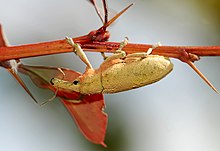Curculionidae: Difference between revisions
mistake |
m Reverted edits by Fir0002 (talk) to last version by Alvesgaspar |
||
| Line 39: | Line 39: | ||
They are recognized by their distinctive long snout and [[geniculate]] antennae with small clubs; beyond that curculionids have considerable diversity of form and size, with adult lengths ranging from 1 [[millimetre|mm]] to 40 mm. |
They are recognized by their distinctive long snout and [[geniculate]] antennae with small clubs; beyond that curculionids have considerable diversity of form and size, with adult lengths ranging from 1 [[millimetre|mm]] to 40 mm. |
||
[[image:Curculionidae.jpg|thumb|left|[[Scanning electron microscope]] (SEM) image of a weevil]] |
|||
Weevils are almost entirely [[plant]] feeders, and most species are associated with a narrow range of hosts, in many cases only living on a single species. |
Weevils are almost entirely [[plant]] feeders, and most species are associated with a narrow range of hosts, in many cases only living on a single species. |
||
| Line 46: | Line 46: | ||
The word weevil has been made famous by the [[Boll Weevil]], which lays its eggs and eats inside cotton bolls, killing the plant. |
The word weevil has been made famous by the [[Boll Weevil]], which lays its eggs and eats inside cotton bolls, killing the plant. |
||
| Line 80: | Line 81: | ||
* [http://creatures.ifas.ufl.edu/orn/turf/hunting_billbug.htm ''Sphenophorus venatus'', hunting billbug] |
* [http://creatures.ifas.ufl.edu/orn/turf/hunting_billbug.htm ''Sphenophorus venatus'', hunting billbug] |
||
{|align=left |
|||
|[[Image:Long nosed weevil.jpg|thumb|250px|left|''Rhinotia hemistictus'']] |
|||
|} |
|||
</BR> |
</BR> |
||
Revision as of 11:35, 23 September 2008
| Curculionidae | |
|---|---|

| |
| Lixus angustatus | |
| Scientific classification | |
| Kingdom: | |
| Phylum: | |
| Class: | |
| Order: | |
| Superfamily: | |
| Family: | Curculionidae Latreille, 1802 |
| Subfamily | |
|
(Some at times are reduced to tribes)
Bagoinae | |
Curculionidae is the family of the "true" weevils (or snout beetles). With over 60,000 species described worldwide, it is the largest of the beetle families.
They are recognized by their distinctive long snout and geniculate antennae with small clubs; beyond that curculionids have considerable diversity of form and size, with adult lengths ranging from 1 mm to 40 mm.

Weevils are almost entirely plant feeders, and most species are associated with a narrow range of hosts, in many cases only living on a single species.
With so many species to classify and over 400 genera, the taxonomy of this family is quite complicated, and authors disagree on the number and placement of various subfamilies, tribes, and subtribes.
The word weevil has been made famous by the Boll Weevil, which lays its eggs and eats inside cotton bolls, killing the plant.
See also
References
External links
On the UF / IFAS Featured Creatures Web site
- Anthonomus eugenii, pepper weevil
- Cylas formicarius, sweetpotato weevil
- Chalcodermus aeneus, cowpea curculio
- Cosmopolites sordidus, banana root borer
- Eudociminus mannerheimii, cypress weevil
- Eurhinus magnificus
- Gerstaeckeria spp.
- Metamasius callizona, Mexican bromeliad weevil
- Metamasius hemipterus sericeus, silky cane weevil,
- Metamasius mosieri, Florida bromeliad weevil
- Naupactus (=Graphognathus) spp., whitefringed beetles
- Oxyops vitiosa, melaleuca weevil
- Pantomorus cervinus, Fuller rose weevil
- Pseudocneorhinus bifasciatus, twobanded Japanese weevil
- Rhynchophorus cruentatus, palmetto weevil
- Sphenophorus venatus, hunting billbug
